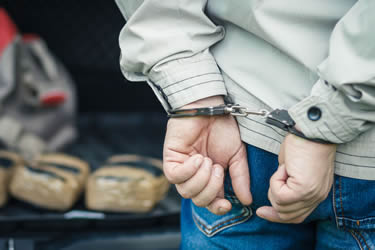
 1-855-378-4228
1-855-378-4228
 1-855-378-4228
1-855-378-4228 Over the past two decades, concerns about violence and crime have prompted an increase in prosecution, law enforcement, and punishment. However, although the 'get tough' approach might have contributed to the recent reduction in crime, there are still some limits to its ability to effectively enhance public safety and well-being over the long haul. This could be because it does little to address the problems of alcohol and drug abuse and addiction. Even though these problems fundamentally affect criminal behavior in about 80% of inmates - as reported by NIDA (the National Institute on Drug Abuse) - only about 1 in every 6 of those in need of comprehensive substance abuse treatment and rehabilitation receive it while incarcerated while far fewer get into an aftercare problem.
Over the past two decades, concerns about violence and crime have prompted an increase in prosecution, law enforcement, and punishment. However, although the 'get tough' approach might have contributed to the recent reduction in crime, there are still some limits to its ability to effectively enhance public safety and well-being over the long haul. This could be because it does little to address the problems of alcohol and drug abuse and addiction. Even though these problems fundamentally affect criminal behavior in about 80% of inmates - as reported by NIDA (the National Institute on Drug Abuse) - only about 1 in every 6 of those in need of comprehensive substance abuse treatment and rehabilitation receive it while incarcerated while far fewer get into an aftercare problem.
As a direct result, prisons continue releasing tens of thousands of inadequately treated or untreated offenders who join communities across the country on an annual basis. This is why it is not surprising that so many addicts who were incarcerated go back to a life of alcohol and drug use and crime.
Fortunately, there is a viable alternative to the policies of the day. In particularly, a variety of treatment-based substitutes have been instituted in place of incarceration. These substitutes are often accompanied by intensive treatment while in prison, as well as aftercare and support services for inmates.
Research also indicates that correctional treatment of drug abuse and addiction is effective at reducing relapse to drug and alcohol use and criminal recidivism. Additionally, some ex-convicts receive community-based treatment and rehabilitation (as well as other services) after parole, which could be the reason behind the drop in re-arrest rates.
To this end, investments in prison treatment and other alternatives to incarceration pay off. Research, for instance, shows that every inmate who completes their prison treatment successfully and receives aftercare, vocational, and educational services at a cost of approximately $6,000 and chooses to remain crime-free, drug-free, and actively employed after their release ends up yielding annual economic benefits ranging to an average of $68,000.
Read on to learn more about treating alcohol and drug abuse and addicted in the criminal justice system, why it is necessary, why it works, and why it should be integrated into the law:
The use and abuse of alcohol, drugs, and other intoxicating substances often has a negative effect on every aspect of life. It, for instance, impacts their community, friends, and family, and also places enormous economic burdens on society at large. In particularly, one of the significant risks that come with abusing drugs and alcohol relates to the connection between drugs, alcohol, and crime.
In the United States, for instance, drugs and alcohol are are involved in close to 80% of all offenses that carry an incarceration sentence. These offenses include, but are not limited to, driving while drunk or intoxicated, public-order offense, drug offenses, property offenses, and domestic violence.
However, the prison population has been exploding way beyond capacity. Not surprisingly, most of the inmates find themselves in prison due to, in large part, substance and alcohol abuse.
Therefore, there is more to drug/alcohol abuse than the negative effects such abuse causes to the individual addict/alcoholic. For instance, statistics show that nearly 80% of all inmates tend to abuse alcohol or drugs while close to 50% of inmates in prison and jail are classified as clinical addicts.
 In the same way, alcohol and drugs have been implicated in all types of offenses and crimes. For instance, most inmates were under the influence of alcohol or drugs (or both) when they committed the crimes for which they were incarcerated. Crimes of violence, in particular, are now commonly associated with alcohol and drug abuse.
In the same way, alcohol and drugs have been implicated in all types of offenses and crimes. For instance, most inmates were under the influence of alcohol or drugs (or both) when they committed the crimes for which they were incarcerated. Crimes of violence, in particular, are now commonly associated with alcohol and drug abuse.
Although the connection between violence and drugs/alcohol is complicated, various plausible biological and psychological mechanisms have been suggested. For instance, being drunk might be used as an alibi by some people for normally proscribed behavior.
Alcohol and drugs may also sharpen aggressive feelings, lower inhibitions, and lead victims and attackers to misread each other's signals in particularly violent social situations. Additionally, these substances might interfere with how the frontal lobe of the brain functions, which may affect your ability to handle threatening or unexpected situations.
Moreover, the neurochemical systems that you subconsciously use to mediate aggressive and violent behavior are likely to be disrupted when you are under the influence of drugs and alcohol.
That said, there are three main types of crimes related to alcohol and drug abuse and addiction. These include:
These crimes occur when you commit an offense for purposes of funding your drug or alcohol habit. They often include, but are not limited to, prostitution and theft.
These refer to those offenses that result from the nature and structure of the alcohol or drug system. As such, they include the sale, possession, transportation, manufacture, and production of drugs (and alcohol for minors). When violence is related to the sale or production of drugs (and alcohol for minors) - think turf wars - it is also considered a system-related crime.
These are legal offenses that involve or result from individuals who ingest drugs and end up committing crime as a direct result of the influence and effects of the drug on their behavior and thought processes.
To this end, it is not surprising that people who are dependent and addicted to drugs and alcohol have a higher likelihood of getting arrested for crimes that are acquisitive, such as handling stolen goods, robbery, shop theft, and burglary, among others. These crimes are often related to feeding the drug/alcohol habit.
Over the past 10 years, however, studies have shown that well-designed and appointed residential treatment programs of a sufficient length and linked to effective aftercare services are ideal for reducing recidivism and post-release relapse.
Through these programs, inmates are often housed in separate units within a large prison facility. Lasting anywhere between 9 and 12 months, the programs are now considered a better alternative to full incarceration.
If successful, the inmate might even be phased through into an independent living facility (or sober living home) even as they continue to maintain contact with the professionals who treated them.
A typical model in treating drug abuse and addiction in the criminal justice system that occurs in prison also involves TCs (therapeutic communities). These communities are effective because they provide structured environments that focus on behavioral modification, intensive therapy, re-socialization, and the gradual increase of responsibility for the patients.
These programs also come with aftercare services that may include post-prison treatment, case management, and transition, as well as alcohol- and drug-free housing, vocational and educational training, and medical or psychological treatment.
Even though these services are sometimes viewed as separate from the core problem of substance abuse and addiction, they are actually crucial. This is because substance abusing offenders in the criminal justice system are often highly vulnerable to relapse within the first few months after they are released from prison, a fact that is often attributed to the psychological and social pressures they face when they rejoin society.
Alcohol and drug-abusing inmates also have a common problem in the sense that they often have sporadic work histories and limited educational backgrounds. Among regular users, 61% of those in state prison were found to have spent less than 4 years in high school.
Unfortunately, poor education, low vocational skills, and substance abuse often operate in a circular pattern. This means that they tend to exacerbate and reinforce each other. In fact, 36% of all regular alcohol and drug users were found to be unemployed in the month right before they were found guilty and sent to prison.
To break this cycle, it is essential that society focuses on treating drug abuse and addiction in the criminal justice system. Studies show that inmates who end up receiving vocational and educational training during their rehabilitation and treatment are much less likely to go back to prison or to substance abuse after their release. This is because they have higher chances of attaining regular employment, which - in turn - enhances their self esteem, helps to reintegrate them back into the community, provides them with a legal and reliable source of regular income, and removes them from the subculture of addiction and substance use.
However, for the treatment to be effective, it is vital that it also includes psychological counseling. This is because mental disorders and substance abuse often go hand in hand. Research, for instance, shows that close to 13% of the entire prison population in the United States have both a mental health and a substance abuse problem - often arising from sexual or physical abuse in childhood.
Among those inmates who regularly abuse alcohol and drugs, a startling 13% of men and 45% of women were victims of sexual or physical abuse - particularly when they were young. Offenders with alcohol or drug problems often show similar rates of abuse in their childhood. Therefore, it is essential that these mental health issues get addressed while treating drug abuse and addiction in the criminal justice system.
 For many people within the criminal justice system, the prevention of future re-arrest and crime committing after discharge from prison/jail is close to impossible without a systemic intervention in the form of addiction treatment and rehabilitation. This is given the fact that approximately 95 percent of all inmates return to drug and alcohol use once they are released from prison while 60 to 80 percent of drug/alcohol abusers end up committing new crimes (typically, ones that are connected to or driven by drugs/alcohol) after they are released from prison.
For many people within the criminal justice system, the prevention of future re-arrest and crime committing after discharge from prison/jail is close to impossible without a systemic intervention in the form of addiction treatment and rehabilitation. This is given the fact that approximately 95 percent of all inmates return to drug and alcohol use once they are released from prison while 60 to 80 percent of drug/alcohol abusers end up committing new crimes (typically, ones that are connected to or driven by drugs/alcohol) after they are released from prison.
To this end, treatment is the best solution because it provides a more effective alternative that would interrupt and disrupt the criminal justice cycle that often affects offenders with alcohol and drug problems.
Research, for instance, shows that treatment and rehabilitation are effective. This means that people - including those in the criminal justice system - can and do recover from drug and alcohol addiction, and end up remaining abstinent from these substances. It also shows that the decline in substance abuse is directly connected to the decline in criminal behavior. Therefore, prison and jail should be places where people are able to get help and assistance when and as they need them.
At the end of the day, treatment saves a great deal of money. A recent study, for instance, found that every dollar spent on drug and alcohol abuse treatment ended up saving over $5 dollars in terms of fewer medical costs, food stamp use, incarcerations, and arrests, as well as less child welfare costs.
Apart from the above, treating drug abuse and addiction in the criminal justice system is logical because as drug and alcohol use decreases, so does criminal behavior. As such, it follows that addiction treatment and prevention is the best way to save valuable tax dollars that would otherwise have been spent incarcerating people who can be saved.
Recent evaluation of prison-based TCs has also shown that good programs are quite effective for substance abuse and addiction treatment, rehabilitation, and aftercare. The Amity Right-turn program instituted by the R.J. Donovan medium-security prison in California, for instance, features 3 phases, namely:
The NDRI (National Development and Research Institutes) conducted a research into the program and found that among those Amity inmates who had completed treatment, rehabilitation, and aftercare only about 8% ended up getting re-incarcerated within a year. This was in stark comparison to 39% of those who had completed the treatment and rehabilitation but had not undergone aftercare, 45% of inmates who failed to complete the treatment, and 50% of inmates in a control group who did not get treated for drug and alcohol abuse and addiction.
Overall, the key to correct the problems linking drugs, alcohol, and crime revolves around effective treatment, rehabilitation, and aftercare for those involved with the criminal justice system. As long as the interventions are intensive, the duration long enough, and the treatments time-tested and found to be effective, it is highly likely that fewer inmates will be leaving jail and prisons with the same problems they had when they went in, or which were responsible for their getting incarcerated in the first place.